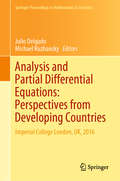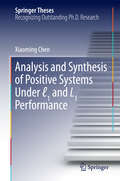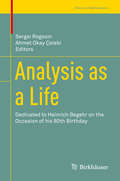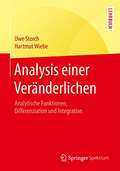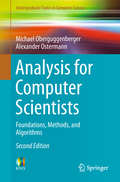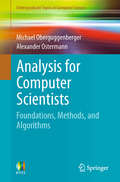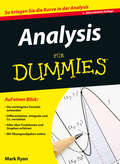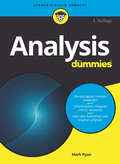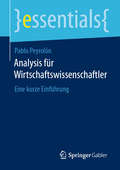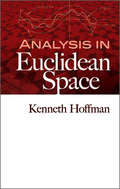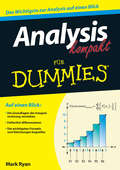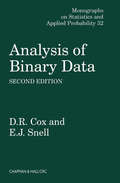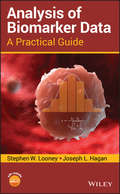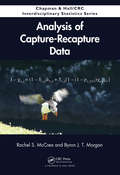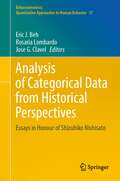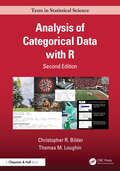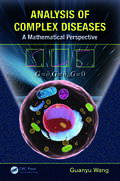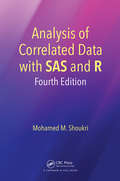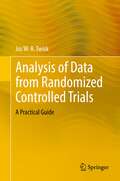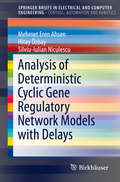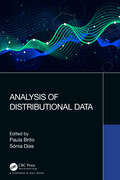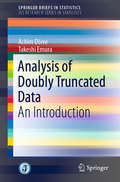- Table View
- List View
Analysis and Partial Differential Equations: Imperial College London, Uk 2016 (Springer Proceedings in Mathematics & Statistics #275)
by Michael Ruzhansky Julio DelgadoThis volume presents current trends in analysis and partial differential equations from researchers in developing countries. The fruit of the project 'Analysis in Developing Countries', whose aim was to bring together researchers from around the world, the volume also includes some contributions from researchers from developed countries. Focusing on topics in analysis related to partial differential equations, this volume contains selected contributions from the activities of the project at Imperial College London, namely the conference on Analysis and Partial Differential Equations held in September 2016 and the subsequent Official Development Assistance Week held in November 2016. Topics represented include Fourier analysis, pseudo-differential operators, integral equations, as well as related topics from numerical analysis and bifurcation theory, and the countries represented range from Burkina Faso and Ghana to Armenia, Kyrgyzstan and Tajikistan, including contributions from Brazil, Colombia and Cuba, as well as India and China. Suitable for postgraduate students and beyond, this volume offers the reader a broader, global perspective of contemporary research in analysis.
Analysis and Synthesis of Positive Systems Under ℓ1 and L1 Performance (Springer Theses)
by Xiaoming ChenThis thesis introduces novel and significant results regarding the analysis and synthesis of positive systems, especially under l1 and L1 performance. It describes stability analysis, controller synthesis, and bounding positivity-preserving observer and filtering design for a variety of both discrete and continuous positive systems. It subsequently derives computationally efficient solutions based on linear programming in terms of matrix inequalities, as well as a number of analytical solutions obtained for special cases. The thesis applies a range of novel approaches and fundamental techniques to the further study of positive systems, thus contributing significantly to the theory of positive systems, a hot topic in the field of control. "
Analysis as a Life: Dedicated to Heinrich Begehr on the Occasion of his 80th Birthday (Trends in Mathematics)
by Sergei Rogosin Ahmet Okay ÇelebiThis is a book comprising selected papers of colleagues and friends of Heinrich Begehr on the occasion of his 80th birthday. It aims at being a tribute to the excellent achievements of Heinrich Begehr in complex analysis and complex differential equations, and especially to his prominent role as one of the creators and long-time leader of the International Society for Analysis, its Applications and Computation (ISAAC).
Analysis einer Veränderlichen: Analytische Funktionen, Differenziation und Integration (Springer-Lehrbuch)
by Uwe Storch Hartmut WiebeLesbar und verständlich trotz einzigartigem Tiefgang.<P> Fördert das Verstehen von Konzepten und Zusammenhängen.<P> Enthält zahlreiche außergewöhnliche Aufgaben und Beispiele.<P>Im Mittelpunkt dieses Lehrbuchs stehen analytische Funktionen sowie Differenziation und Integration von Funktionen einer Veränderlichen. Dabei werden Begriffe wie Stetigkeit und Konvergenz von Folgen und Reihen vorausgesetzt. Der Stoff wird durch zahlreiche Beispiele und Aufgaben illustriert und ergänzt. Das Buch ist zum Selbststudium geeignet, aber vor allem konzipiert als Begleitlektüre von Anfang an für ein Studium der Mathematik, Physik und Informatik. Die stringente Herangehensweise macht es gut lesbar und vergleichsweise leicht verständlich.
Analysis for Computer Scientists: Foundations, Methods, And Algorithms (Undergraduate Topics in Computer Science)
by Michael Oberguggenberger Alexander OstermannThis easy-to-follow textbook/reference presents a concise introduction to mathematical analysis from an algorithmic point of view, with a particular focus on applications of analysis and aspects of mathematical modelling. The text describes the mathematical theory alongside the basic concepts and methods of numerical analysis, enriched by computer experiments using MATLAB, Python, Maple, and Java applets. This fully updated and expanded new edition also features an even greater number of programming exercises.Topics and features: describes the fundamental concepts in analysis, covering real and complex numbers, trigonometry, sequences and series, functions, derivatives, integrals, and curves; discusses important applications and advanced topics, such as fractals and L-systems, numerical integration, linear regression, and differential equations; presents tools from vector and matrix algebra in the appendices, together with further information on continuity; includes added material on hyperbolic functions, curves and surfaces in space, second-order differential equations, and the pendulum equation (NEW); contains experiments, exercises, definitions, and propositions throughout the text; supplies programming examples in Python, in addition to MATLAB (NEW); provides supplementary resources at an associated website, including Java applets, code source files, and links to interactive online learning material.Addressing the core needs of computer science students and researchers, this clearly written textbook is an essential resource for undergraduate-level courses on numerical analysis, and an ideal self-study tool for professionals seeking to enhance their analysis skills.
Analysis for Computer Scientists: Foundations, Methods, and Algorithms (Undergraduate Topics in Computer Science)
by Michael Oberguggenberger Alexander OstermannThis textbook presents an algorithmic approach to mathematical analysis, with a focus on modelling and on the applications of analysis. Fully integrating mathematical software into the text as an important component of analysis, the book makes thorough use of examples and explanations using MATLAB, Maple, and Java applets. Mathematical theory is described alongside the basic concepts and methods of numerical analysis, supported by computer experiments and programming exercises, and an extensive use of figure illustrations. Features: thoroughly describes the essential concepts of analysis; provides summaries and exercises in each chapter, as well as computer experiments; discusses important applications and advanced topics; presents tools from vector and matrix algebra in the appendices, together with further information on continuity; includes definitions, propositions and examples throughout the text; supplementary software can be downloaded from the book's webpage.
Analysis für Dummies (Für Dummies)
by Mark RyanAnalysis ist Ihnen ein Graus, aber die Prüfung steht vor der Tür? Keine Sorge! "Analysis für Dummies" führt Sie an das Thema heran und wiederholt zunächst die Grundlagen von Algebra, Funktionen und Grafen. Anschließend erläutert der Autor die Regeln der Differentialrechnung, die Feinheiten der Kurvendiskussion sowie das Entscheidende zu Grenzwerten und Stetigkeit. Dank zahlreicher Beispiele und Schritt-für-Schritt-Erklärungen werden Sie schon bald zum Experten. Durch online zur Verfügung gestellte Übungsaufgaben und Lösungen können Sie das Gelernte festigen und Ihren Erfolg überprüfen. So steht der bestandenen Prüfung nichts im Wege.
Analysis für Dummies (Für Dummies)
by Mark RyanAnalysis ist Ihnen ein Graus, aber die Klausur steht vor der Tür? Keine Sorge! "Analysis für Dummies" führt Sie an das Thema heran und wiederholt zunächst die Grundlagen von Algebra, Funktionen und Graphen. Anschließend erläutert der Autor die Regeln der Differentialrechnung, die Feinheiten der Kurvendiskussion sowie das Entscheidende zu Grenzwerten und Stetigkeit. Dank zahlreicher Beispiele und Schritt-für-Schritt-Erklärungen werden Sie schon bald zum Experten. So steht der bestandenen Prüfung nichts im Wege.
Analysis für Wirtschaftswissenschaftler: Eine kurze Einführung (essentials)
by Pablo PeyrolónAnalysis (Calculus auf Englisch) hat einen sehr schlechten Ruf zwischen Studenten, Schüler und Laien. Das liegt oft an der extremen Abstraktion von Konzepte wie Ableitung oder Integrale. Mit einer Kombination aus der Geschichte der Analysis und mathematische Entwicklung versuche ich Analysis positiv zu präsentieren, die Basics erklären mit dem Ziel, dass wenn man ein Analysis Lehrbuch nimmt, sich nicht mehr fürchten muss. All die Erklärungen sind fokussiert an der Anwendung der Analysis für Wirtschaftswissenschaften Leibniz und Newton, Eltern der modernen Analysis, und Euler, helfen uns bei dieser Einführung in die Analysis mit Geschichte.
Analysis in Euclidean Space
by Kenneth HoffmanDeveloped for an introductory course in mathematical analysis at MIT, this text focuses on concepts, principles, and methods. Its introductions to real and complex analysis are closely formulated, and they constitute a natural introduction to complex function theory.Starting with an overview of the real number system, the text presents results for subsets and functions related to Euclidean space of n dimensions. It offers a rigorous review of the fundamentals of calculus, emphasizing power series expansions and introducing the theory of complex-analytic functions. Subsequent chapters cover sequences of functions, normed linear spaces, and the Lebesgue interval. They discuss most of the basic properties of integral and measure, including a brief look at orthogonal expansions. A chapter on differentiable mappings concludes the text, addressing implicit and inverse function theorems and the change of variable theorem. Exercises appear throughout the book, and extensive supplementary material includes a bibliography, list of symbols, index, and appendix with background in elementary set theory
Analysis in Euclidean Space (Dover Books on Mathematics)
by Kenneth HoffmanDeveloped for an introductory course in mathematical analysis at MIT, this text focuses on concepts, principles, and methods. Its introductions to real and complex analysis are closely formulated, and they constitute a natural introduction to complex function theory. Starting with an overview of the real number system, the text presents results for subsets and functions related to Euclidean space of n dimensions. It offers a rigorous review of the fundamentals of calculus, emphasizing power series expansions and introducing the theory of complex-analytic functions. Subsequent chapters cover sequences of functions, normed linear spaces, and the Lebesgue interval. They discuss most of the basic properties of integral and measure, including a brief look at orthogonal expansions. A chapter on differentiable mappings addresses implicit and inverse function theorems and the change of variable theorem. Exercises appear throughout the book, and extensive supplementary material includes a Bibliography, List of Symbols, Index, and an Appendix with background in elementary set theory.
Analysis kompakt fur Dummies (Für Dummies)
by Mark RyanAn der Analysis kommen Sie nicht vorbei: Sei es nun in der Schule oder wenn Sie Natur-, Ingenieurs-, oder Wirtschaftswissenschaften studieren. Dieses Buch hilft Ihnen, wenn Sie sich einen schnellen Überblick über das Thema verschaffen wollen. Mark Ryan erklärt Ihnen leicht verständlich, was Sie über Grenzwerte und Funktionen unbedingt wissen sollten. So ist dies Ihr perfekter Nachhilfelehrer für die Tasche: freundlich, kompetent, günstig.
Analysis of Arithmetic for Mathematics Teaching
by Gaea LeinhardtThis volume emerges from a partnership between the American Federation of Teachers and the Learning Research and Development Center at the University of Pittsburgh. The partnership brought together researchers and expert teachers for intensive dialogue sessions focusing on what each community knows about effective mathematical learning and instruction. The chapters deal with the research on, and conceptual analysis of, specific arithmetic topics (addition, subtraction, multiplication, division, decimals, and fractions) or with overarching themes that pervade the early curriculum and constitute the links with the more advanced topics of mathematics (intuition, number sense, and estimation). Serving as a link between the communities of cognitive researchers and mathematics educators, the book capitalizes on the recent research successes of cognitive science and reviews the literature of the math education community as well.
Analysis of Binary Data (Chapman And Hall/crc Monographs On Statistics And Applied Probability Ser. #32)
by D.R. CoxThe first edition of this book (1970) set out a systematic basis for the analysis of binary data and in particular for the study of how the probability of 'success' depends on explanatory variables. The first edition has been widely used and the general level and style have been preserved in the second edition, which contains a substantial amount of new material. This amplifies matters dealt with only cryptically in the first edition and includes many more recent developments. In addition the whole material has been reorganized, in particular to put more emphasis on m.aximum likelihood methods.There are nearly 60 further results and exercises. The main points are illustrated by practical examples, many of them not in the first edition, and some general essential background material is set out in new Appendices.
Analysis of Biomarker Data
by Stephen W. Looney Joseph L. HaganA "how to" guide for applying statistical methods to biomarker data analysisPresenting a solid foundation for the statistical methods that are used to analyze biomarker data, Analysis of Biomarker Data: A Practical Guide features preferred techniques for biomarker validation. The authors provide descriptions of select elementary statistical methods that are traditionally used to analyze biomarker data with a focus on the proper application of each method, including necessary assumptions, software recommendations, and proper interpretation of computer output. In addition, the book discusses frequently encountered challenges in analyzing biomarker data and how to deal with them, methods for the quality assessment of biomarkers, and biomarker study designs. Covering a broad range of statistical methods that have been used to analyze biomarker data in published research studies, Analysis of Biomarker Data: A Practical Guide also features:A greater emphasis on the application of methods as opposed to the underlying statistical and mathematical theoryThe use of SAS®, R , and other software throughout to illustrate the presented calculations for each exampleNumerous exercises based on real-world data as well as solutions to the problems to aid in reader comprehensionThe principles of good research study design and the methods for assessing the quality of a newly proposed biomarkerA companion website that includes a software appendix with multiple types of software and complete data sets from the book's examplesAnalysis of Biomarker Data: A Practical Guide is an ideal upper-undergraduate and graduate-level textbook for courses in the biological or environmental sciences. An excellent reference for statisticians who routinely analyze and interpret biomarker data, the book is also useful for researchers who wish to perform their own analyses of biomarker data, such as toxicologists, pharmacologists, epidemiologists, environmental and clinical laboratory scientists, and other professionals in the health and environmental sciences.
Analysis of Capture-Recapture Data (Chapman & Hall/CRC Interdisciplinary Statistics)
by Rachel S. McCrea Byron J. MorganAn important first step in studying the demography of wild animals is to identify the animals uniquely through applying markings, such as rings, tags, and bands. Once the animals are encountered again, researchers can study different forms of capture-recapture data to estimate features, such as the mortality and size of the populations. Capture-rec
Analysis of Categorical Data from Historical Perspectives: Essays in Honour of Shizuhiko Nishisato (Behaviormetrics: Quantitative Approaches to Human Behavior #17)
by Eric J. Beh Rosaria Lombardo Jose G. ClavelThis collection of essays is in honor of Shizuhiko Nishisato on his 88th birthday and consists of invited contributions only. The book contains essays on the analysis of categorical data, which includes quantification theory, cluster analysis, and other areas of multidimensional data analysis, covering more than half a century of research by the 41 interdisciplinary and international researchers who are contributors. Thus, it offers the wisdom and experience of work past and present and attracts a new generation of researchers to this field. Central to this wisdom and experience is that of Prof. Nishisato, who has spent much of the past 60 years mentoring and providing leadership in the research of quantification theory, especially that of “dual scaling”. The book includes contributions by leading researchers who have worked alongside Prof. Nishisato, published with him, been mentored by him, or whose work has been influenced by the research he has undertaken over his illustrious career. This book inspires researchers young and old as it highlights the significant contributions, past and present, that Prof. Nishisato has made in his field.
Analysis of Categorical Data with R (Chapman & Hall/CRC Texts in Statistical Science)
by Christopher R. Bilder Thomas M. LoughinAnalysis of Categorical Data with R, Second Edition presents a modern account of categorical data analysis using the R software environment. It covers recent techniques of model building and assessment for binary, multicategory, and count response variables and discusses fundamentals, such as odds ratio and probability estimation. The authors give detailed advice and guidelines on which procedures to use and why to use them.The second edition is a substantial update of the first based on the authors’ experiences of teaching from the book for nearly a decade. The book is organized as before, but with new content throughout, and there are two new substantive topics in the advanced topics chapter—group testing and splines. The computing has been completely updated, with the "emmeans" package now integrated into the book. The examples have also been updated, notably to include new examples based on COVID-19, and there are more than 90 new exercises in the book. The solutions manual and teaching videos have also been updated.Features: Requires no prior experience with R, and offers an introduction to the essential features and functions of R Includes numerous examples from medicine, psychology, sports, ecology, and many other areas Integrates extensive R code and output Graphically demonstrates many of the features and properties of various analysis methods Offers a substantial number of exercises in all chapters, enabling use as a course text or for self-study Supplemented by a website with data sets, code, and teaching videos Analysis of Categorical Data with R, Second Edition is primarily designed for a course on categorical data analysis taught at the advanced undergraduate or graduate level. Such a course could be taught in a statistics or biostatistics department, or within mathematics, psychology, social science, ecology, or another quantitative discipline. It could also be used by a self-learner and would make an ideal reference for a researcher from any discipline where categorical data arise.
Analysis of Complex Diseases: A Mathematical Perspective
by PhD, Guanyu WangA complex disease involves many etiological and risk factors operating at multiple levels-molecular, cellular, organismal, and environmental. The incidence of such diseases as cancer, obesity, and diabetes are increasing in occurrence, urging us to think fundamentally and use a broader perspective to identify their connection and revolutionize trea
Analysis of Correlated Data with SAS and R
by Mohamed M. ShoukriAnalysis of Correlated Data with SAS and R: 4th edition presents an applied treatment of recently developed statistical models and methods for the analysis of hierarchical binary, count and continuous response data. It explains how to use procedures in SAS and packages in R for exploring data, fitting appropriate models, presenting programming codes and results. The book is designed for senior undergraduate and graduate students in the health sciences, epidemiology, statistics, and biostatistics as well as clinical researchers, and consulting statisticians who can apply the methods with their own data analyses. In each chapter a brief description of the foundations of statistical theory needed to understand the methods is given, thereafter the author illustrates the applicability of the techniques by providing sufficient number of examples. The last three chapters of the 4th edition contain introductory material on propensity score analysis, meta-analysis and the treatment of missing data using SAS and R. These topics were not covered in previous editions. The main reason is that there is an increasing demand by clinical researchers to have these topics covered at a reasonably understandable level of complexity. Mohamed Shoukri is principal scientist and professor of biostatistics at The National Biotechnology Center, King Faisal Specialist Hospital and Research Center and Al-Faisal University, Saudi Arabia. Professor Shoukri’s research includes analytic epidemiology, analysis of hierarchical data, and clinical biostatistics. He is an associate editor of the 3Biotech journal, a Fellow of the Royal Statistical Society and an elected member of the International Statistical Institute.
Analysis of Data from Randomized Controlled Trials: A Practical Guide
by Jos W.R. TwiskThis book provides a practical guide to the analysis of data from randomized controlled trials (RCT). It gives an answer to the question of how to estimate the intervention effect in an appropriate way. This problem is examined for different RCT designs, such as RCTs with one follow-up measurement, RCTs with more than one follow-up measurement, cluster RCTs, cross-over trials, stepped wedge trials, and N-of-1 trials. The statistical methods are explained in a non-mathematical way and are illustrated by extensive examples. All datasets used in the book are available for download, so readers can reanalyse the examples to gain a better understanding of the methods used. Although most examples are taken from epidemiological and clinical studies, this book is also highly recommended for researchers working in other fields.
Analysis of Deterministic Cyclic Gene Regulatory Network Models with Delays (SpringerBriefs in Electrical and Computer Engineering)
by Mehmet Eren Ahsen Hitay Özbay Silviu-Iulian NiculescuThis brief examines a deterministic, ODE-based model for gene regulatory networks (GRN) that incorporates nonlinearities and time-delayed feedback. An introductory chapter provides some insights into molecular biology and GRNs. The mathematical tools necessary for studying the GRN model are then reviewed, in particular Hill functions and Schwarzian derivatives. One chapter is devoted to the analysis of GRNs under negative feedback with time delays and a special case of a homogenous GRN is considered. Asymptotic stability analysis of GRNs under positive feedback is then considered in a separate chapter, in which conditions leading to bi-stability are derived. Graduate and advanced undergraduate students and researchers in control engineering, applied mathematics, systems biology and synthetic biology will find this brief to be a clear and concise introduction to the modeling and analysis of GRNs.
Analysis of Distributional Data
by Paula BritoIn a time when increasingly larger and complex data collections are being produced, it is clear that new and adaptive forms of data representation and analysis have to be conceived and implemented. Distributional data, i.e., data where a distribution rather than a single value is recorded for each descriptor, on each unit, come into this framework. Distributional data may result from the aggregation of large amounts of open/collected/generated data, or it may be directly available in a structured or unstructured form, describing the variability of some features. This book provides models and methods for the representation, analysis, interpretation, and organization of distributional data, taking into account its specific nature, and not relying on a reduction to single values, to be conform to classical paradigms.Conceived as an edited book, gathering contributions from multiple authors, the book presents alternative representations and analysis’ methods for distributional data of different types, and in particular,-Uni- and bi-variate descriptive statistics for distributional data-Clustering and classification methodologies-Methods for the representation in low-dimensional spaces-Regression models and forecasting approaches for distribution-valued variables Furthermore, the different chapters -Feature applications to show how the proposed methods work in practice, and how results are to be interpreted, -Often provide information about available software. The methodologies presented in this book constitute cutting-edge developments for stakeholders from all domains who produce and analyse large amounts of complex data, to be analysed in the form of distributions. The book is hence of interest for companies operating not only in the area of data analytics, but also on logistics, energy and finance. It also concerns national statistical institutes and other institutions at European and international level, where microdata is aggregated to preserve confidentiality and allow for analysis at the appropriate regional level. Academics will find in the analysis of distributional data a challenging up-to-date field of research.
Analysis of Doubly Truncated Data: An Introduction (SpringerBriefs in Statistics)
by Takeshi Emura Achim DörreThis book introduces readers to statistical methodologies used to analyze doubly truncated data. The first book exclusively dedicated to the topic, it provides likelihood-based methods, Bayesian methods, non-parametric methods, and linear regression methods. These procedures can be used to effectively analyze continuous data, especially survival data arising in biostatistics and economics. Because truncation is a phenomenon that is often encountered in non-experimental studies, the methods presented here can be applied to many branches of science. The book provides R codes for most of the statistical methods, to help readers analyze their data. Given its scope, the book is ideally suited as a textbook for students of statistics, mathematics, econometrics, and other fields.
Analysis of Electrical Circuits with Variable Load Regime Parameters: Projective Geometry Method (Power Systems)
by A. PeninThis book introduces electric circuits with variable loads and voltage regulators. It allows to define invariant relationships for various parameters of regime and circuit sections and to prove the concepts characterizing these circuits. Generalized equivalent circuits are introduced. Projective geometry is used for the interpretation of changes of operating regime parameters. Expressions of normalized regime parameters and their changes are presented. Convenient formulas for the calculation of currents are given. Parallel voltage sources and the cascade connection of multi-port networks are described. The two-value voltage regulation characteristics of loads with limited power of voltage source is considered. The book presents the fundamentals of electric circuits and develops circuit theorems. It is useful to engineers, researchers and graduate students who are interested in the basic electric circuit theory and the regulation and monitoring of power supply systems.
